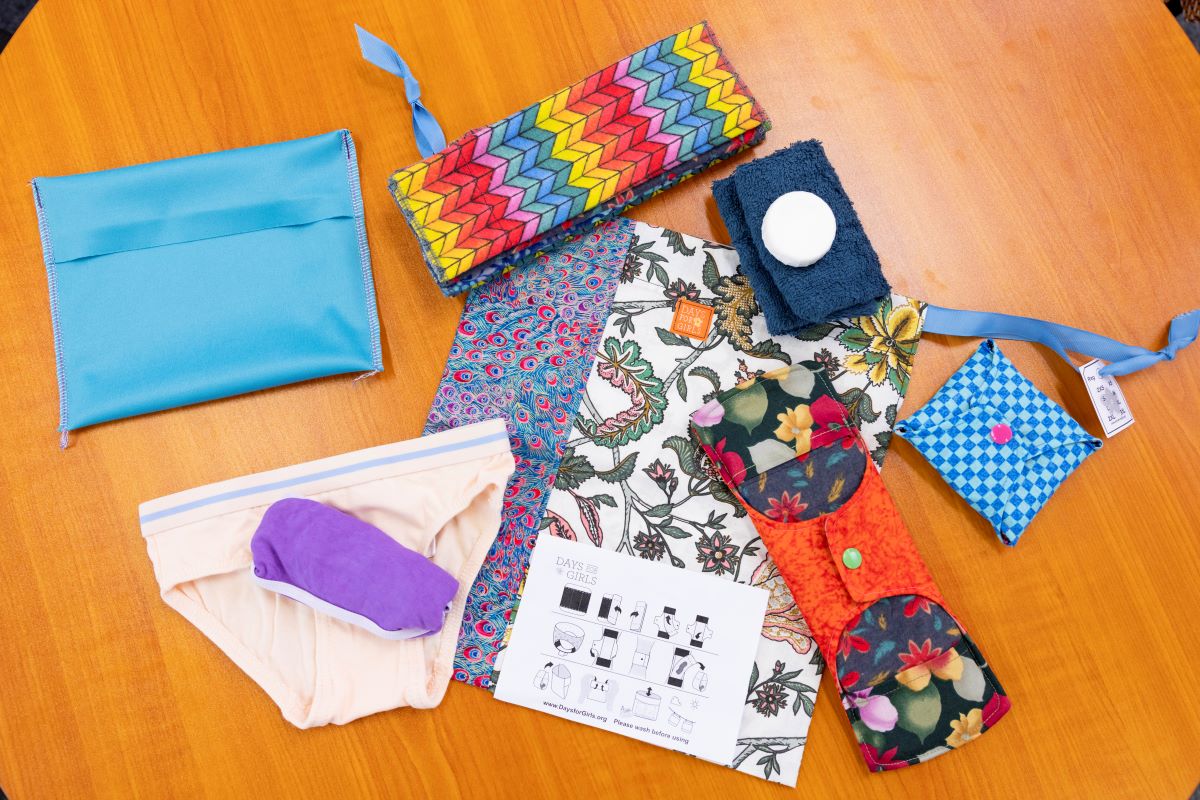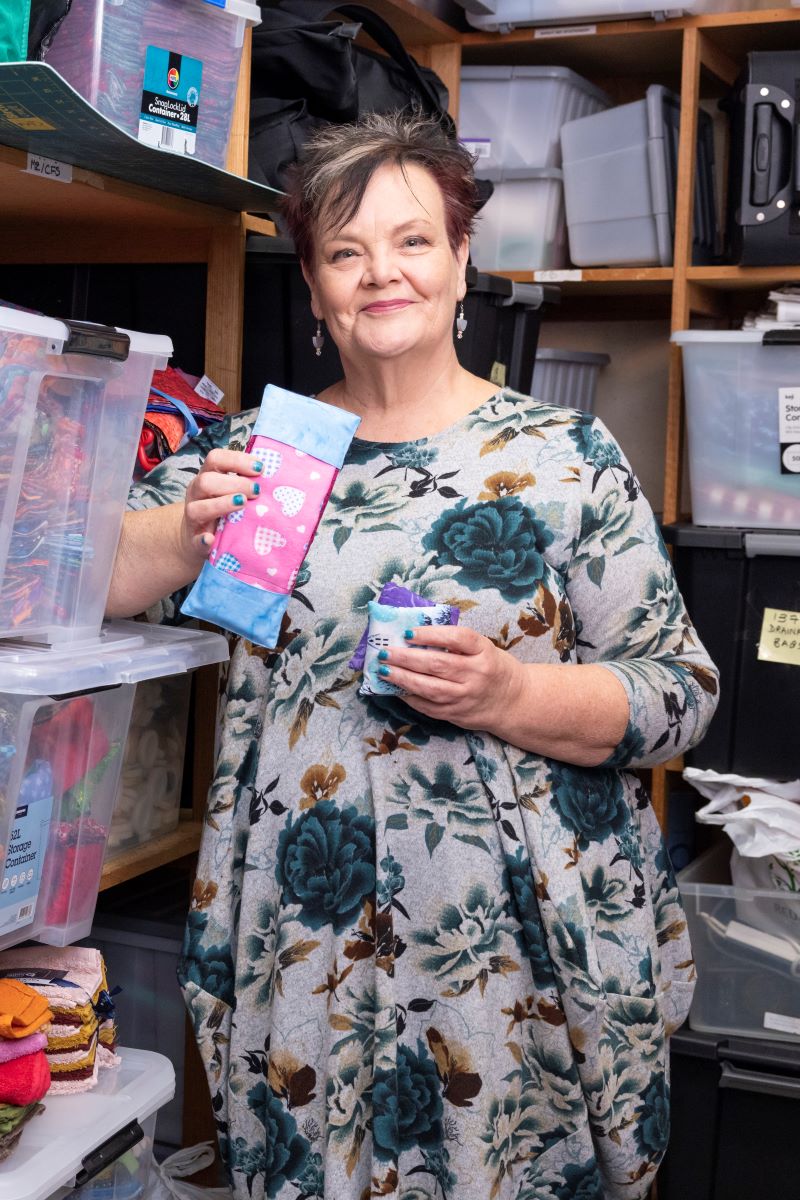For many girls around the world, the start of womanhood means the end of education as they don’t have access to resources to contain their flow, leaving them stuck at home. A group of dedicated Canberra crafters create menstruation kits to be delivered to these girls and women in the Sew for Change program.
“If you look worldwide, 530 million women and girls don’t have what they need to manage their period. 130 million don’t go to school; 75 per cent of those are girls and they usually leave school at 12,” says Carol Mead, founder and chair of Canberra Circle of Women.
The organisation started out as four friends sewing dresses for girls in developing countries eight years ago. Just six months later, Ms Mead realised there was something these girls needed more than clothes – access to education.
Under the umbrella of Canberra Circle of Women are different programs, or circles – some knit, some sew, one is social. The sewing program is called Sew for Change. While they still make clothes for children, they put a lot of time and energy into Days for Girls.
“It’s actually giving the girls their days back. What happens is, a girl in Africa will miss nine weeks of school a year because there’s a big shame about periods and they’re often at home like they were sick … [Days for Girls] gives them the nine weeks back,” Ms Mead says.
Missing weeks of school puts the girls behind permanently, and she says there are no catch-up programs; by the time they hit their teens, they’ve missed so much they give up.
“They often marry at 12 or 13, start having babies at 14 and then their life is basically one of servitude,” Ms Mead says. “It gives women and girls a level playing field to get an education, to build a career, to ensure that they’re not going to have no choice in their future.”
The menstruation kit
Each Days for Girls period kit lasts up to four years and teaches girls and women how to manage their periods. The pack includes a carrier that can be used as a backpack, a waterproof transport bag for soiled items, a pad or shield that snaps underneath underwear, and six washable liners.
“We’re dealing with countries which don’t often have toilets, they’re trying to do this in the field, so it has to be as easy as possible,” Ms Mead says.

Kits also include laundry soap, which is often a precious commodity, a face washer, and two pairs of underwear. The shield and liners don’t work without a pair of undies, which is something Ms Mead says most of the recipients don’t own.
“When you don’t have underwear and wear a long sarong, there’s a big problem. They use things like corn husks, bark, grass, very old dirty rags, all those things for periods because they will do what they need to do,” she says.
Recipients are also given a chart to track their cycle, a washable pictorial of how to care for their kit, and an hour of education about what a period is: where it comes from, why, and how often.
Without the kits, Ms Mead says many girls wouldn’t learn about periods before experiencing them. In some countries, the subject isn’t raised until students start biology in year eight, which is too late for most.
Days for Girls
The Days for Girls campaign has grown to include 150 volunteers from across the Eastern seaboard. At one point, they supported 18 different countries; now to make more of an impact they focus on three – Pakistan, The Philippines, and Sri Lanka.
Helping these girls to become well-educated women benefits their whole community, Ms Mead says, as an educated woman will build the community and will always educate her children.
“It’s all about ensuring that they can stay in school, and not only get an education – it reduces child marriage, it reduces having babies early, it encourages them to go and find work, and supports the community,” she says.
The program was founded by Celeste Mergens, who on a trip to an orphanage in Kenya woke up one night wondering how the girls manage their periods, and was horrified by their answers.
“She was told that they sit in a dark room on a piece of cardboard for five days and people would come in and just bring them water or a bit of food,” Ms Mead says. “She said to them ‘What if you really wanted to go to school that day?’ and they said ‘We need to go to the teacher and let them use [have sex with] us and he will give us a pad’.”
Since Days for Girls began in 2008, the program has reached more than 2.8 million women and girls worldwide, according to the 2022 annual report. Teams are partnered with organisations or people on the ground in the countries in need, and everyone involved undertakes training.

Across Australia, there are more than 170 different teams creating kits for the Days for Girls program, sending the products to a central location to be delivered to the target communities by trusted individuals or charity groups. Ms Mead prefers to partner with individuals who can get to hard-to-reach women.
“Lubna, for instance, in Pakistan, she goes out to all the brickworks in her area, there’s a lot of these brickwork areas, and those are very poor people that charities don’t meet.”
Many hands make light work with people contributing what they can, each job as important as the next: collecting suitable materials from donors, washing donated fabrics, cutting the patterns, stitching the pieces together, and spending a day packing everything for delivery. The team compile around 280 kits each monthly packing day and have shipped more than 7,500 in total.
Women can receive additional pieces for their kits as needed and sometimes a mother or grandmother might take a few to give to family. Part of the training is to ensure users know they can’t be shared.
“We started with the girls, and then the girls started talking, and what you don’t want is them to share the kit because this needs to be the particular person’s kit. So, we will give a kit to all the women in the family,” Ms Mead says.
To help cover freight costs, which can be up to $2,000 per month, the circle also makes goods for the quarterly Pearce Crafters Market.
Ms Mead says the circles often draw in women edging towards retirement who are looking for something to do. The circle provides them with socialising, a sense of purpose, and a reason to use skills they may have forgotten.
“It’s reducing isolation, it’s reducing depression, it increases that community feel and friendship. For the women here, it’s really important, as well as for the people we serve,” she says.
Find out more about Days for Girls and the other programs run by the Canberra Circle of Women on Facebook via Sew for Change.
Get all the latest Canberra news, sport, entertainment, lifestyle, competitions and more delivered straight to your inbox with the Canberra Daily Daily Newsletter. Sign up here.



